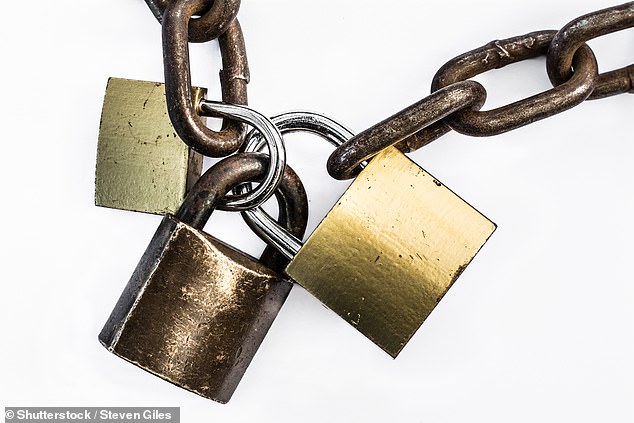The Tories and Labour are both reportedly planning to commit to keeping the popular state pension triple lock in their election manifestos.
The triple lock pledge means the state pension should increase every year by the highest of inflation, average earnings growth or 2.5 per cent.
Older people will get an 8.5 per cent boost to the state pension from April 2024, the Chancellor confirmed the triple lock in the Autumn Statement.
The wages growth figure decided the next rise, after the September CPI inflation number came in at 6.7 per cent.

Next state pension rise: Headline rate will increase by an annual £902 to £11,500 thanks to the triple lock pledge
How much is the state pension now?
The 10.1 per cent inflation hike last April means pensioners receiving the post-2016 full rate state pension get £203.85 a week or £10,600 a year.
Those on the basic rate, who reached state pension age before April 2016, get £156.20 a week or £8,120 a year.
But people on the basic rate also get hefty top-ups, called S2P or Serps, if those were earned earlier in life.
Our pensions columnist Steve Webb explains how different elements of the state pension are raised, such as graduated and SERPS (the second state pension, for those who earned it in the past).
How much will the state pension rise by in April?
The headline full rate state pension will increase to £221.20 per week – up £902 a year to around £11,500 – in April 2024.
The basic rate will be £169.50 a week, up £692 a year to around £8,800.
How is the triple lock calculated?
The crunch CPI inflation rate figure used in the calculation is taken from September, and was published in October 2023, coming in at 6.7 per cent.
The key earnings growth figure, for total pay including bonuses, is for the three months to July, and published in September. It was revealed as 8.5 per cent in September 2023.
> State pension triple lock will drag 650,000 more into tax net
What has happened to the triple lock recently?
In autumn 2022, the inflation rate was 10.1 per cent, which was what the state pension rose by in April 2023 – fulfilling the triple lock pledge.
But the Government sparked fury by scrapping the earnings element from the state pension rise in April 2022, because wage growth was temporarily distorted to more than 8 per cent due to the pandemic.
Instead, pensioners received a meagre 3.1 per cent hike, using the inflation figure from the previous autumn before it started to soar.
The triple lock was introduced by David Cameron’s Conservative Government in the 2011/2012 financial year, to ensure pensioners receive a decent rise in income every year.
The 2.5 per cent element keeps pushing the rate higher even in years when earnings and inflation are flat. The table below shows that it has kicked in four times over the years.

This table shows what decided state pension rises through the triple lock years (Source IFS)
Before the triple lock state pensions were increased in line with price inflation, going back to 1980. This infamously once led to a 75p increase, which caused huge anger against the Labour government in 1999 and the early 2000s.
Since then all Governments and Oppositions have tried to avoid a repeat of this damaging row when announcing plans for state pension increases.
Why is the triple lock controversial?
Critics point out that maintaining the triple lock is expensive when public finances are in a straitened state, and some question whether the elderly should get a bumper state pension increase when workers are handed below inflation pay deals.
STEVE WEBB ANSWERS YOUR PENSION QUESTIONS

Supporters say that unlike with the temporary wage growth spike after the pandemic, pensioners are currently struggling with the very real challenge of high inflation while on a fixed income.
Many depend solely on the stage pension, and are having a tough time paying sky-high food and energy bills.
The UK also has the lowest state pension among rich countries based on one of the most cited international measures, although that does not tell the whole story because some nations roll their state and workplace schemes into one system.
Aside from the moral case and fairness argument in favour of a full hike, elderly people tend to vote in high numbers.
None of the major political parties want to upset this key voting bloc by denying them a decent state pension increase.
How much does the state pension cost?
The cost is rolled into other spending on pensioners, including housing benefit, pension credit and winter fuel payments, as well as the state pension.
The Office for Budget Responsibility says this totalled £126.4billion in 2022/23 and is expected to hit £142.1 in 2023/24 and £153.billion in 2024/25.
Will the triple lock survive the next election?
Pressure on public finances might force a change at some point, perhaps to a double lock system.
However. it is most unlikely either the Tories or Labour will go into the election with a manifesto promise to ditch the triple lock.
That is, unless they decided to ‘jump together’. Again, unlikely. Neither will want to forfeit any advantage they can get to appeal to older voters.
Media reports are already emerging which suggest both parties plan to recommit to the triple lock before the next election.
Some links in this article may be affiliate links. If you click on them we may earn a small commission. That helps us fund This Is Money, and keep it free to use. We do not write articles to promote products. We do not allow any commercial relationship to affect our editorial independence.



